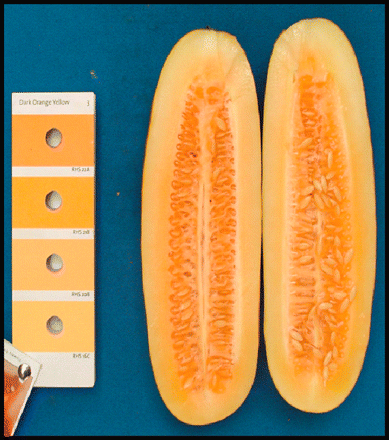Cucumbers are one of the most widely-grown vegetables in the world. Baker Creek Heirloom Seeds (a great place to buy unusual and international veggie seeds) lists 51 varieties from North America, Southeast Asia, China, India, Mexico, and Europe. Dark green ones seem to be in the minority – yellow, white, orange and red skins in shapes round to elongated dominate.
Cukes traditionally have a few nutrients including some Vitamin A from carotenoids and beta carotene, but have never had the reputation as nutritional power house. Watery and gas-inducing, yes.
Researchers with the USDA have recently released a cucumber high in beta carotene. No "frankencuke" this; all the crossing was done by traditionally breeding methods (including bees and self-pollination). Lots and lots of crosses with a warty, round-ish chinese cuke (Cucumis sativus var. xishuangbannanesis) and some standard pickling cukes has resulted in a stable cultivar that has the smoother skin and proper proportions of marketable pickling cucumbers (there are lots of marketing standards associated with most fruits and veggies). But the big news is the orange interior, specifically the endocarp (the jelly-like stuff around the seeds) and the mesocarp (the fleshy part that is the whole point). It’s orange because it’s full of beta carotene (mesocarp is 2.7 micrograms per gram of fresh fruit compared to 0.02 micrograms per gram with a traditional white-fleshed variety. Even more impressive is the jump in endocarp beta carotene – from 0.16 micrograms per gram to 7.5 micrograms per gram). I don’t believe the USDA is going to release this particular line directly to the public, rather they’re offering the genetics (two recessive genes control the beta carotene content) to other breeders. This means other breeders can use it in their own breeding program to bring more nutritional value to their specific lines, at which point varieties will become available to growers/gardeners. Orange tzatziki!!!

(Linked, but my guess it won’t work if you don’t have a HortScience subscription or institutional access, sorry)
Wow, looks like a melon!
Did they say anything about taste or texture? Too often veggies are bred to improve some characteristic but all the taste goes away. Some of the newer parthenocarpic cukes (Diva, for example) are much better in texture and taste than other varieties. (Just ate the last one from our vines yesterday and will miss them until next summer.)
This just in…author/breeder Phil Simon answered some questions for me… “The skin is green. Commercial availability will depend on whether any seed company picks this up. So far we don’t know of any. Regarding vitamin A delivery, there is a 10- to 20-fold higher content than standard cukes.
So you still need to eat a lot of pickles. Yes, the pigment is retained upon pickling.”
And Sandy, these can’t taste any worse than yer basic grocery store cuke. There are very limited seeds available apparently, but he’s going to send me a couple. So will report back next summer!
And invite us all to a taste test??? 😉
And in other timely veggie breeding news, UK Scientists grow super broccoli.